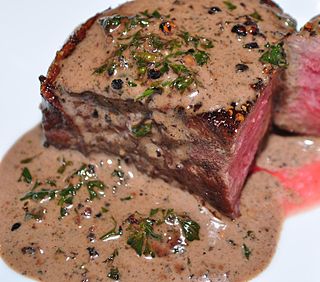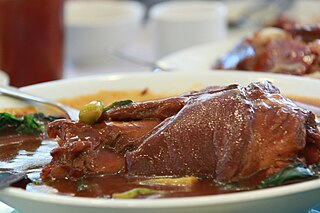
Black pepper is a flowering vine in the family Piperaceae, cultivated for its fruit, which is usually dried and used as a spice and seasoning, known as a peppercorn. When fresh and fully mature, it is about 5 mm (0.20 in) in diameter and dark red, and contains a single seed, like all drupes. Peppercorns and the ground pepper derived from them may be described simply as pepper, or more precisely as black pepper, green pepper, and white pepper.

Under the English feudal system several different forms of land tenure existed, each effectively a contract with differing rights and duties attached thereto. Such tenures could be either free-hold, signifying that they were hereditable or perpetual, or non-free where the tenancy terminated on the tenant's death or at an earlier specified period. The main varieties are as follows:
Blanching is a cooking process wherein a food, usually a vegetable or fruit, is scalded in boiling water, removed after a brief, timed interval, and finally plunged into iced water or placed under cold running water to halt the cooking process. Blanching foods helps reduce quality loss over time. People often use blanching as a pre-treatment prior to freezing, drying, or canning—heating vegetables or fruits to inactivate enzymes, modify texture, remove the peel, and wilt tissue. Blanching is also utilized to preserve color, flavor, and nutritional value. The process has three stages: preheating, blanching, and cooling. The most common blanching methods for vegetables/fruits are hot water and steam, while cooling is either done using cold water or cool air. Other benefits of blanching include removing pesticide residues and decreasing microbial load. Drawbacks to the blanching process can include leaching of water-soluble and heat sensitive nutrients and the production of effluent.
Farming or tax-farming is a technique of financial management, namely the process of commuting (changing), by its assignment by legal contract to a third party, a future uncertain revenue stream into fixed and certain periodic rents, in consideration for which commutation a discount in value received is suffered. It is most commonly used in the field of public finance, where the state wishes to gain some certainty about its future taxation revenue for the purposes of medium-term budgetting of expenditure. The tax collection process requires considerable expenditure on administration and the yield is uncertain both as to amount and timing, as taxpayers delay or default on their assessed obligations, often the result of unforeseen external forces such as bad weather affecting harvests. Governments have thus frequently over history resorted to the services of an entrepreneurial financier to whom they lease or assign the right to collect and retain the whole of the tax revenue due to the state in return for his payment into the treasury of fixed sums. Sometimes the tax farmer was a government employee, paid a salary, and all monies collected went to the government.
A gilliflower or gillyflower is:

In the Middle Ages, especially under the European feudal system, feoffment or enfeoffment was the deed by which a person was given land in exchange for a pledge of service. This mechanism was later used to avoid restrictions on the passage of title in land by a system in which a landowner would give land to one person for the use of another. The common law of estates in land grew from this concept.

The London and North Eastern Railway (LNER) Peppercorn Class A1 is a type of express passenger steam locomotive. Forty-nine original Peppercorn Class A1s were built to the design of Arthur Peppercorn during the early British Railways era, but all were scrapped with the discontinuation of steam, with none of the original production run surviving into preservation. In 2008, a brand new 50th Peppercorn A1 locomotive, 60163 Tornado, was completed.
Blanch or blanching may refer to:

The London and North Eastern Railway (LNER) Peppercorn Class A2 is a class of steam locomotive designed for express passenger work by Arthur Peppercorn, the chief designer of the LNER after Edward Thompson. All save the first of the 15 built were constructed under British Railways after nationalisation in 1948.
Feu was previously the most common form of land tenure in Scotland, as conveyancing in Scots law was dominated by feudalism until the Scottish Parliament passed the Abolition of Feudal Tenure etc. (Scotland) Act 2000. The word is the Scots variant of fee. The English had in 1660 abolished these tenures, with An Act taking away the Court of Wards..., since 1948 known as the Tenures Abolition Act 1660.

Steak au poivre or pepper steak is a French dish that consists of a steak, traditionally a filet mignon, coated with coarsely cracked peppercorns and then cooked. The peppercorns form a crust on the steak when cooked and provide a pungent but complementary counterpoint to the rich flavor of the high-quality beef.

The London and North Eastern Railway (LNER) Class K1 is a type of 2-6-0 (mogul) steam locomotive designed by Edward Thompson. Thompson preferred a simple two-cylinder design instead of Gresley's three cylinder one. The seventy K1s were intended to be split between the North Eastern Region of British Railways and the Eastern Region of British Railways.

In legal parlance, a peppercorn is a metaphor for a very small payment, a nominal consideration, used to satisfy the requirements for the creation of a legal contract. It featured in Chappell & Co Ltd v Nestle Co Ltd, which stated that "peppercorn do not cease to be good consideration if it is established that the promisee does not like pepper and will throw away the corn".

Bierwurst is a German cooked, smoked Brühwurst sausage originally from Bavaria, with a garlicky flavor and dark red color. It is seasoned with black peppercorns, paprika, and mustard seeds for flavor.
In French mythology or folklore, Dames Blanches were female spirits or supernatural beings, comparable to the White Women of both Dutch and Germanic mythology. The Dames Blanches were reported in the region of Lorraine (Lotharingen) and Normandy. They appear, in the Pyrenees mountains, where they were supposed to appear near caves and caverns.

Umberto Eusepi is an Italian professional football player. Currently, he plays for Novara on loan from Pisa.
In English and Irish law, a fee farm grant is a hybrid type of land ownership typical in cities and towns. The word fee is derived from fief, meaning a feudal landholding, and a fee farm grant is similar to a fee simple in the sense that it gives the grantee the right to hold a freehold estate, the only difference being the payment of an annual rent and covenants, thus putting both parties in a landlord-tenant relationship.

Mala sauce is a popular oily, spicy, and numbing Chinese sauce which consists of Sichuanese peppercorn, chili pepper and various spices simmered with oil.
An Album, in ancient Rome, was a board chalked or painted white, on which decrees, edicts and other public notices were inscribed in black.

Pata tim, also spelled patatim, is a Filipino braised pork hock dish slow-cooked until very tender in soy sauce, black peppercorns, garlic, bay leaves, muscovado, and star anise sweetened with muscovado sugar. It also commonly includes péchay and mushrooms. The dish is commonly served in regions in the Philippines with large Chinese Filipino populations, especially in the Binondo district of Manila.













